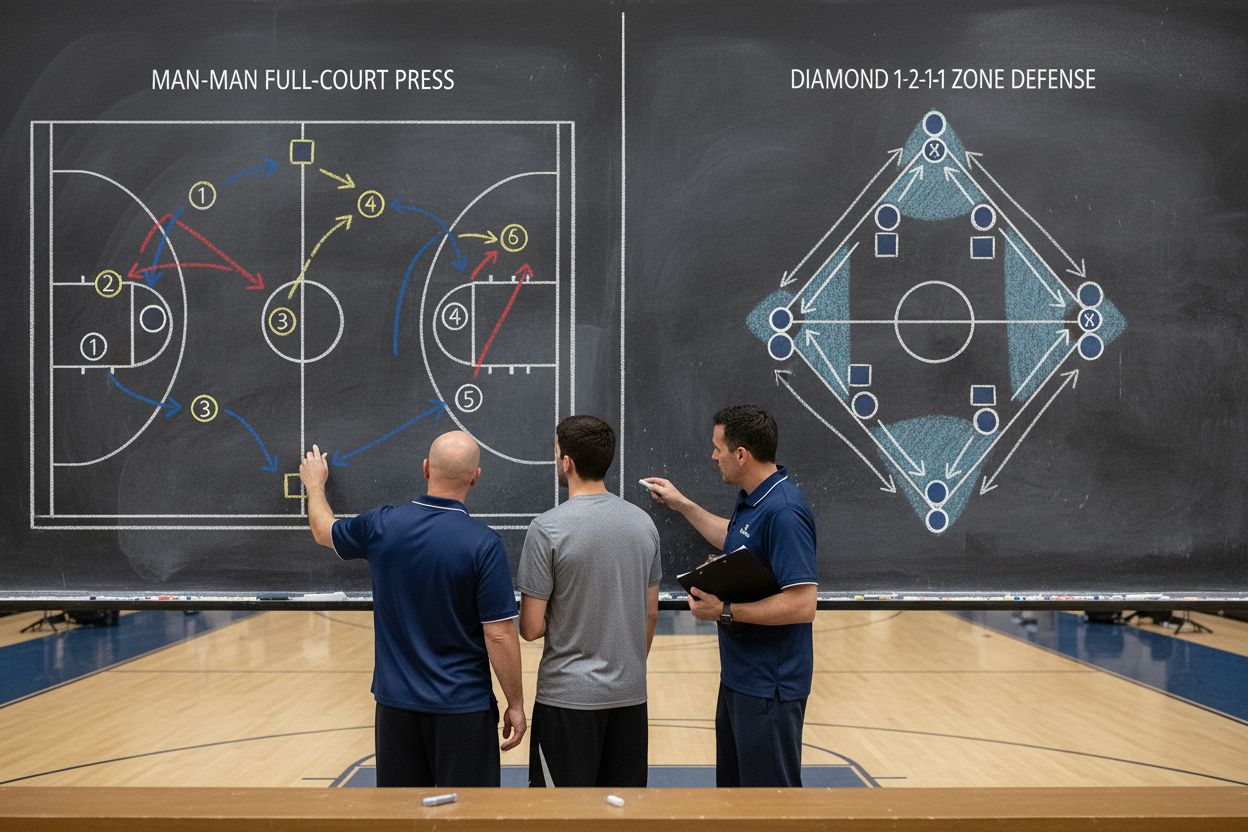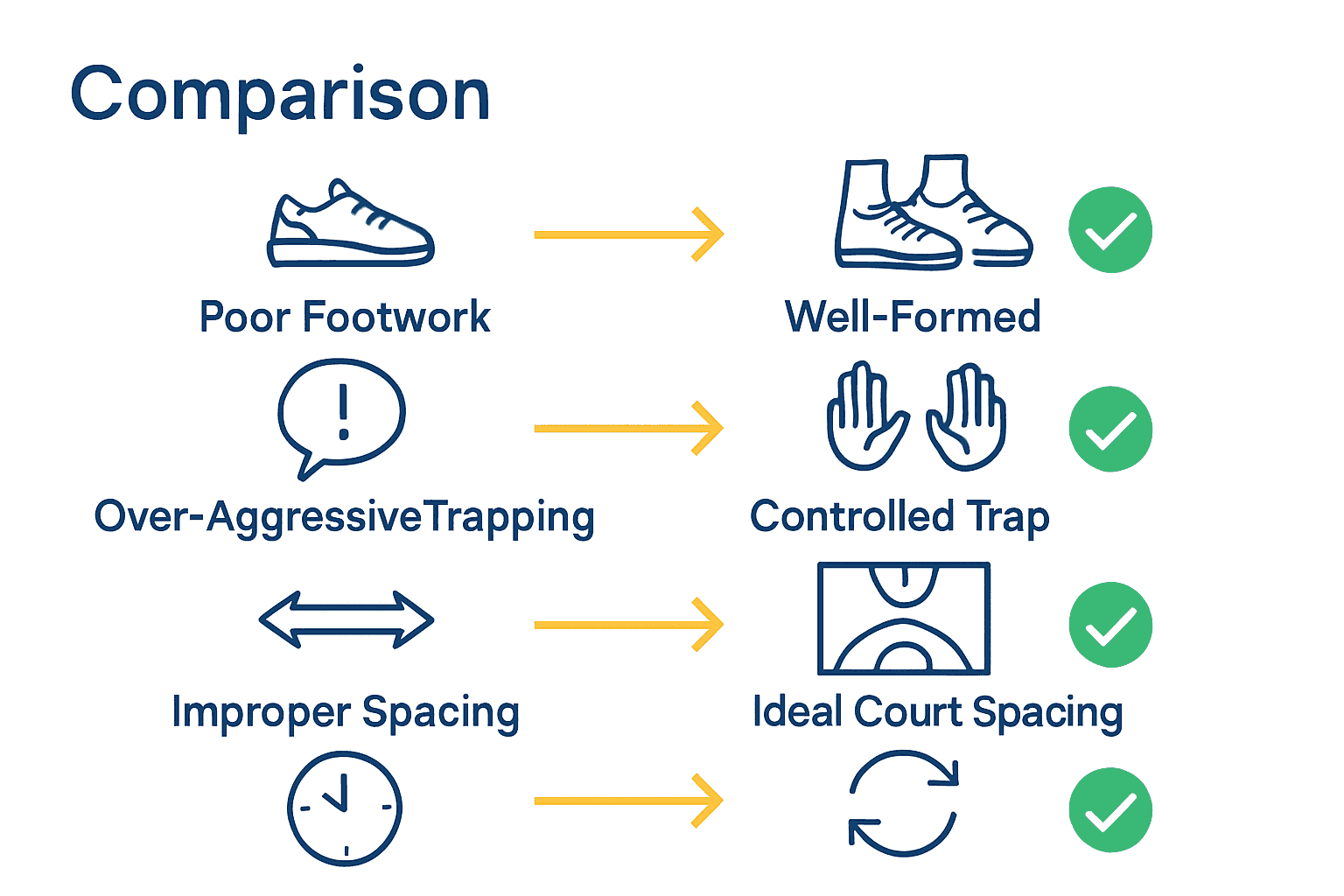Did you know some teams have forced up to 30 turnovers per game using a full court press? This aggressive defensive move has changed high-stakes basketball, turning pressure into quick points and momentum swings. Knowing how the full court press works, why coaches rely on it, and how teams make or break their success with it will transform the way you understand defensive tactics on the court.
Key Takeaways
| Point | Details |
|---|---|
| Full Court Press Overview | An aggressive defensive strategy that disrupts opponents’ flow by applying pressure across the entire court immediately after ball possession changes. |
| Key Defensive Formations | The full court press can be executed using a man-to-man or zone approach, each focusing on different aspects of defensive coverage. |
| Player and Coaching Roles | Success relies on clear communication, specific player responsibilities, and precise strategic planning to effectively implement the press. |
| Common Mistakes | Frequent errors like poor footwork and improper spacing can undermine the press; targeted training can help mitigate these issues. |
Table of Contents
- Defining Full Court Press In Basketball
- Main Types Of Full Court Press Defense
- Implementing A Full Court Press Successfully
- Coaching Roles And Player Responsibilities
- Common Mistakes And How To Avoid Them
Defining Full Court Press In Basketball
A full court press represents one of basketball’s most aggressive defensive strategies, designed to disrupt opponent’s offensive flow and create immediate scoring opportunities. According to Wikipedia, this tactic involves defenders applying intense pressure across the entire court, typically starting immediately after ball possession changes.
Historically, the full court press emerged in the 1950s, pioneered by innovative coaches who recognized its potential to overwhelm opponents. Research indicates that legendary coaches like John McLendon, Gene Johnson, and Nolan Richardson popularized this strategy, transforming it from a novel concept to a respected competitive technique. Richardson’s famous “40 Minutes of Hell” approach perfectly exemplified how relentless defensive pressure could completely control game dynamics.
The full court press can be executed in two primary defensive formations:
- Man-to-Man Press: Defenders match up individually with specific offensive players
- Zone Press: Defenders cover specific court areas rather than individual players
Coaches strategically deploy this approach when facing teams with:
- Weak ball handlers
- Limited bench depth
- Inexperienced point guards
By reading more about breaking a full court press, coaches and players can develop comprehensive strategies to both implement and counter this high-intensity defensive technique.
Main Types Of Full Court Press Defense
In basketball defense, full court press strategies come in multiple sophisticated variations, each designed to disrupt opponent ball movement and create turnover opportunities. According to Masterclass, these defensive approaches fundamentally break down into two primary categories: man-to-man and zone-based full court presses.
Man-to-Man Full Court Press
In a man-to-man full court press, each defender is assigned to shadow a specific offensive player across the entire court. This approach demands exceptional individual defensive skills, communication, and stamina. Defenders aim to deny passing lanes, pressure ball handlers, and force quick, potentially erroneous decisions.
Zone Full Court Press Variations
Basketball Coach Weekly highlights several zone press formations:
- 1-2-1-1 (Diamond) Press: Creates a diamond-shaped defensive formation with strategic trapping zones
- 1-2-2 Press: Utilizes two defenders at the front to create initial pressure
- Run-and-Jump Press: Involves defenders switching and trapping unexpectedly
Coaches select these variations based on team strengths, opponent weaknesses, and game situation. Learn more about executing press break strategies to understand both sides of this intense defensive tactic.
Here’s a comparison of the main full court press defensive formations:
| Press Type | Formation Example | Defensive Focus | Key Advantage |
|---|---|---|---|
| Man-to-Man Press | All defenders matched | Individual pressure Denial |
Forces 1-on-1 mistakes |
| Zone Press | 1-2-1-1 (Diamond) 1-2-2 Run-and-Jump |
Area coverage Trapping zones |
Creates confusion Forces turnovers |

Implementing A Full Court Press Successfully
Successful full court press implementation requires a strategic blend of physical conditioning, mental discipline, and precise team coordination. According to Masterclass, the core foundation lies in players’ ability to maintain high-energy defensive pressure without experiencing rapid fatigue.
Key Physical and Mental Requirements
Executing an effective full court press demands exceptional athlete preparation:
- Peak Conditioning: Players must possess extraordinary cardiovascular endurance
- Mental Toughness: Sustained concentration and aggressive defensive mindset
- Team Synchronization: Precise communication and coordinated defensive movements
Strategic Implementation Steps
To deploy a successful full court press, coaches should focus on:
- Develop specialized conditioning programs targeting press-specific stamina
- Create defensive drills simulating high-intensity game scenarios
- Establish clear communication protocols during defensive transitions
- Practice quick defensive rotations and trapping techniques
Understanding defensive principles is crucial. Check out our comprehensive 2-2-1 Zone Press Guide to gain deeper insights into mastering this intense defensive strategy. The most effective presses emerge from teams with superior fitness, unwavering commitment, and synchronized defensive execution.
Coaching Roles And Player Responsibilities
Full court press defense represents a complex strategic system where each player must understand their precise role and execute it with exceptional discipline. According to Rockstar Academy, coaching responsibilities extend far beyond traditional defensive assignments, requiring meticulous planning and real-time tactical adjustments.
Specific Player Positions and Responsibilities
Some coaches like the diamond (1-2-1-1) press formation, which defines critical player roles:
- Disruptor: Pressures the ball immediately after inbound
- Wing Defenders: Create strategic traps in sideline and corner zones
- Interceptor: Protects the middle of the court
- Safety: Shields against potential long-range passing opportunities
Coaching Strategic Responsibilities
Coaches must focus on:
- Assign specific defensive responsibilities
- Design precise trapping locations
- Develop communication protocols
- Train players to anticipate and read offensive movements
- Practice rapid defensive rotations
Learn more about essential basketball leadership techniques that can help coaches effectively implement and manage complex defensive strategies like the full court press. Success depends on clear communication, synchronized team movement, and unwavering defensive intensity.
Common Mistakes And How To Avoid Them
Full court press defense demands precision and discipline, but coaches and players frequently encounter critical errors that can undermine the entire defensive strategy. According to The Hoops Geek, several common mistakes can compromise the effectiveness of this high-intensity defensive approach.
Fundamental Defensive Mistakes
The most prevalent errors in full court press implementation include:
- Poor Footwork: Compromises defensive positioning and reaction speed
- Overly Aggressive Trapping: Leads to unnecessary fouls and defensive breakdowns
- Improper Spacing: Creates gaps that offensive teams can exploit
- Late Defensive Rotations: Allows easy passing and scoring opportunities
Strategic Mistake Prevention
Coaches can mitigate these issues through targeted training:
- Implement extensive footwork and positioning drills
- Teach controlled, strategic trapping techniques
- Practice precise defensive spacing and communication
- Develop quick decision-making and rotation skills
- Emphasize positioning over reaching
Learn more about avoiding defensive breakdowns to ensure your full court press remains a powerful defensive weapon. Success comes from understanding these nuanced defensive principles and dedicating time to perfecting them through consistent, focused practice.

Elevate Your Full Court Press With Proven Coaching Resources
Looking to implement a game-changing full court press but frustrated by common breakdowns like poor spacing or missed traps? Many coaches struggle to translate high-energy strategy into efficient on-court execution. If you want to transform relentless pressure into genuine results, you need a foundation built on detailed systems and clear communication. Our Basketball Guides are crafted for coaches like you who aim perfect both offensive and defensive strategies.

Achieve the consistency and confidence your team needs. Each resource at Hoop Mentality is developed from real coaching experience and provides step-by-step structures for practice planning, defensive drills, and real-game adjustments. Do not wait as competitive advantages are earned in preparation. Browse our Full Court Press Playbooks and All Products to take action on your next winning season.
Frequently Asked Questions
What is a full court press in basketball?
A full court press is an aggressive defensive strategy in basketball where defenders apply pressure to the opposing team across the entire court immediately after a change in possession, aiming to disrupt their offense and create turnovers.
What are the main types of full court press defenses?
The primary types of full court press defenses are the man-to-man press, where defenders match up with specific offensive players, and zone presses, where defenders cover designated areas of the court instead of individual players.
How do you successfully implement a full court press?
Successful implementation of a full court press requires peak physical conditioning, strong mental focus, clear communication among players, and practiced defensive rotations. Coaches should develop specialized drills to enhance stamina and coordination.
What common mistakes should be avoided when using a full court press?
Common mistakes include poor footwork, overly aggressive trapping, improper spacing, and late defensive rotations. Coaches can mitigate these issues through targeted training and drills that focus on positioning, controlled trapping, and quick decision-making.

